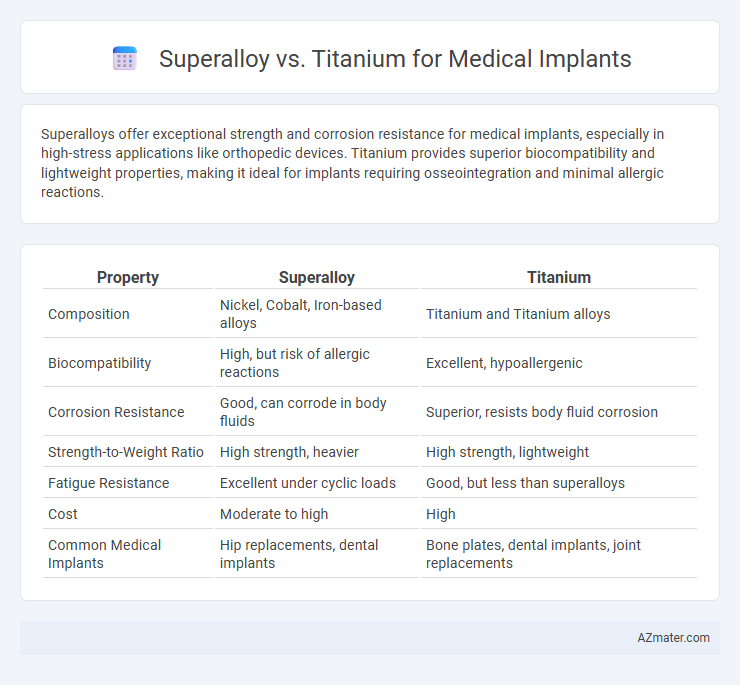Superalloys offer exceptional strength and corrosion resistance for medical implants, especially in high-stress applications like orthopedic devices. Titanium provides superior biocompatibility and lightweight properties, making it ideal for implants requiring osseointegration and minimal allergic reactions.
Table of Comparison
| Property | Superalloy | Titanium |
|---|---|---|
| Composition | Nickel, Cobalt, Iron-based alloys | Titanium and Titanium alloys |
| Biocompatibility | High, but risk of allergic reactions | Excellent, hypoallergenic |
| Corrosion Resistance | Good, can corrode in body fluids | Superior, resists body fluid corrosion |
| Strength-to-Weight Ratio | High strength, heavier | High strength, lightweight |
| Fatigue Resistance | Excellent under cyclic loads | Good, but less than superalloys |
| Cost | Moderate to high | High |
| Common Medical Implants | Hip replacements, dental implants | Bone plates, dental implants, joint replacements |
Introduction to Superalloys and Titanium in Medical Implants
Superalloys, composed primarily of nickel, cobalt, and iron, offer exceptional strength, corrosion resistance, and high-temperature stability, making them ideal for load-bearing medical implants such as orthopedic devices and cardiovascular stents. Titanium and its alloys, known for their biocompatibility, lightweight nature, and excellent corrosion resistance, are widely used in dental implants, joint replacements, and bone fixation devices. Both materials are essential in medical implant technology, with superalloys excelling in durability and titanium favored for its compatibility with human tissue.
Material Composition and Properties Overview
Superalloys, primarily composed of cobalt, chromium, and nickel, exhibit exceptional corrosion resistance, high tensile strength, and excellent biocompatibility, making them suitable for load-bearing medical implants such as joint replacements. Titanium and its alloys, characterized by a lighter weight and a high strength-to-weight ratio due to the presence of aluminum and vanadium, offer superior osseointegration and corrosion resistance in physiological environments. Both materials demonstrate excellent fatigue resistance, but titanium's lower modulus of elasticity reduces stress shielding, improving long-term implant performance.
Biocompatibility: Superalloy vs Titanium
Titanium exhibits superior biocompatibility compared to superalloys, being highly resistant to corrosion and promoting osseointegration essential for medical implants. Superalloys such as cobalt-chromium and nickel-based alloys offer excellent mechanical strength but may cause hypersensitivity and metal ion release, raising biocompatibility concerns. Titanium's inert surface minimizes immune response and supports long-term implant stability in orthopedic and dental applications.
Mechanical Strength and Durability Comparison
Superalloys exhibit superior mechanical strength compared to titanium, providing exceptional resistance to deformation and wear in medical implants. Titanium offers excellent biocompatibility and corrosion resistance but typically has lower tensile strength and fatigue resistance than superalloys. The enhanced durability of superalloys makes them suitable for high-stress implant applications where prolonged mechanical performance is critical.
Corrosion Resistance in the Human Body
Superalloys exhibit exceptional corrosion resistance in the human body due to their robust oxide film formation, which protects implants from degradation in physiological environments. Titanium, however, provides superior biocompatibility and forms a highly stable titanium dioxide layer that resists bodily fluids and reduces ion release. While superalloys offer strength and corrosion resistance, titanium is often preferred for medical implants because of its excellent corrosion resistance combined with lightweight and enhanced osseointegration properties.
Weight and Density Considerations for Implants
Superalloys exhibit high strength and corrosion resistance but have a higher density, typically around 8.0 g/cm3, making them heavier than titanium alloys, which range from 4.4 to 4.6 g/cm3. Titanium's lower density contributes to lighter medical implants, enhancing patient comfort and reducing stress on surrounding bone structures. Weight considerations are critical for long-term implant success, with titanium often preferred for load-bearing applications due to its strength-to-weight ratio and biocompatibility.
Osseointegration and Biological Response
Superalloys and titanium differ significantly in osseointegration and biological response when used for medical implants. Titanium exhibits superior biocompatibility and osseointegration due to its stable oxide layer, promoting strong bone bonding and minimal inflammatory reaction. In contrast, superalloys often provoke a less favorable biological response and weaker integration because of their corrosion susceptibility and potential metal ion release.
Manufacturing and Processing Differences
Superalloys, such as cobalt-chromium and nickel-based alloys, demand high-temperature processing and precision casting or forging methods to achieve their superior strength and corrosion resistance in medical implants. Titanium and its alloys, favored for biocompatibility and lower density, benefit from advanced manufacturing techniques like additive manufacturing and cold working, enabling intricate designs and enhanced fatigue performance. The difference in processing temperatures and techniques directly influences the microstructure, mechanical properties, and cost-effectiveness of medical implants made from superalloys versus titanium.
Cost-Effectiveness and Accessibility
Superalloys, particularly cobalt-chromium and titanium alloys, offer high strength and corrosion resistance essential for medical implants but often come with higher raw material and manufacturing costs compared to pure titanium. Titanium's biocompatibility, lower density, and widespread availability result in reduced production expenses and enhanced accessibility for diverse healthcare markets, making it a cost-effective solution for implants such as joint replacements and dental fixtures. Considering lifecycle costs, titanium's superior osseointegration reduces the need for revision surgeries, further improving its economic efficiency over superalloy alternatives.
Clinical Applications and Future Prospects
Superalloys like cobalt-chromium exhibit exceptional wear resistance and biocompatibility, making them ideal for load-bearing medical implants such as hip and knee replacements. Titanium and its alloys offer superior corrosion resistance, lower density, and excellent osseointegration, which enhances bone bonding in dental and orthopedic implants. Future prospects emphasize the development of hybrid implants combining superalloys' strength with titanium's biocompatibility and the use of additive manufacturing for patient-specific implant designs.

Infographic: Superalloy vs Titanium for Medical Implant
 azmater.com
azmater.com